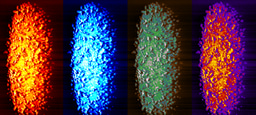Viral Bcl-2 homologs: Old Dog with New Tricks
Published in Microbiology

Mitochondria are best known as the cell’s power generators, but their role extends far beyond metabolism. They are central hubs for stress signaling and antiviral defense. One of their key functions in infection is to serve as a platform for the protein MAVS (mitochondrial antiviral signaling protein), which resides on the outer mitochondrial membrane and activates interferon production. This makes mitochondria central player in the cellular fight against viral infection, and not surprisingly, frequent targets of viral manipulation.
In our recent study published in Nature Microbiology, we discovered how Kaposi’s sarcoma-associated herpesvirus (KSHV), a cancer-causing herpesvirus, co-opts mitochondrial architecture to evade immune detection at the late stage of its life cycle. This architectural change turns out to be essential for successful virion morphogenesis. The unexpected player in this process is vBcl-2, a viral homolog of the human Bcl-2 protein. vBcl-2 has long been recognized for its ability to block apoptosis and autophagy, prolonging host cell survival during infection. However, while studying KSHV in its native genomic context, we observed that deletion of vBcl-2 completely blocked productive infection. Surprisingly, replacing it with a mutant form that lacked both anti-apoptotic and anti-autophagic activities fully rescued viral replication. This pointed to a previously unknown role of vBcl-2-one unrelated to its canonical functions.
To explore this, we performed a yeast two-hybrid screen to identify host proteins that bind vBcl-2. We discovered a strong and specific interaction with NM23-H2, a member of the nucleoside diphosphate kinase (NDPK) family. NDPKs catalyze phosphate exchange reactions that maintain cellular pools of nucleoside triphosphates like GTP. Although this activity is shared across the family, NM23-H2 stood out for its ability to promote GTP loading of selective GTPases. Notably, we found that vBcl-2-associated NM23-H2 can activate DRP1, a dynamin-related GTPase that drives mitochondrial fission.This finding intrigued us because we observed that fragmented mitochondria are less capable of organizing MAVS signaling, and thus less capable of activating interferon responses. Specifically, we found that vBcl-2 directly binds NM23-H2, recruits it to the mitochondria, and boosts its activity, leading to enhanced DRP1 activation and mitochondrial fission. Importantly, this structural remodeling is not incidental. It’s a virus-driven, coordinated reshaping of mitochondria that disrupts immune signaling and creates conditions conducive to virion maturation.
When vBcl-2 is absent, or when the interaction between vBcl-2 and NM23-H2 is disrupted, mitochondria remain un-fragmented, MAVS forms immune-activating aggregates, and the interferon response is robustly engaged. As a result, the virus stalls during capsid assembly, fails to exit the nucleus, and infectious virions are not produced. We also identified two interferon-stimulated genes, TRIM22 and MxB, that act downstream of this response to restrict viral capsid transport.These genes were strongly upregulated in the absence of vBcl-2, and silencing them restored capsid egress and virion yield. These findings highlight the significance of late-stage innate immunity—and reveal how mitochondrial structure itself influences these checkpoints.
To explore therapeutic implications, we ran a high-throughput screen of over 60,000 compounds for inhibitors that block the vBcl-2–NM23-H2 interaction. We identified a lead compound, VBNI-1, that selectively disrupts this interface without affecting vBcl-2’s traditional binding surfaces. Treatment with VBNI-1 preserved mitochondrial integrity, restored MAVS signaling, and sharply reduced KSHV virion production. It’s worth noting that traditional Bcl-2 inhibitors target the BH3-binding groove, which wasn’t essential for KSHV replication. Instead, VBNI-1 hits a completely different surface on vBcl-2, one required for this newly found mitochondrial function.
This work reshapes our view of viral Bcl-2 proteins. Rather than simply keeping infected cells alive, vBcl-2 has evolved an additional function: reprogramming mitochondrial architecture to suppress immunity and support the final steps of viral production. It expands the functional repertoire of the Bcl-2 family and places mitochondrial dynamics at the heart of virus–host conflict. Moreover, this strategy may not be unique to KSHV. Other herpesviruses, including Epstein-Barr virus and rhesus rhadinovirus, encode Bcl-2 homologs and may exploit similar mechanisms. If so, targeting virus-driven mitochondrial remodeling could represent a broader antiviral strategy.
What began as a simple question—“what else does vBcl-2 do?”—led us to uncover an intricate viral mechanism that connects metabolism, immunity, and organelle dynamics. It also reinforced a broader principle: cellular architecture is not passive. It is a highly regulated battleground—and viruses, ever adaptive, know exactly how to exploit it.
Written by Qing Zhu (Staff Scientist, The Wistar Institute) and Chengyu Liang (Professor, The Wistar Institute)
Follow the Topic
-
Nature Microbiology

An online-only monthly journal interested in all aspects of microorganisms, be it their evolution, physiology and cell biology; their interactions with each other, with a host or with an environment; or their societal significance.
Related Collections
With Collections, you can get published faster and increase your visibility.
Progress towards the Sustainable Development Goals
Publishing Model: Hybrid
Deadline: Ongoing
The Clinical Microbiome
Publishing Model: Hybrid
Deadline: Mar 11, 2026






Please sign in or register for FREE
If you are a registered user on Research Communities by Springer Nature, please sign in